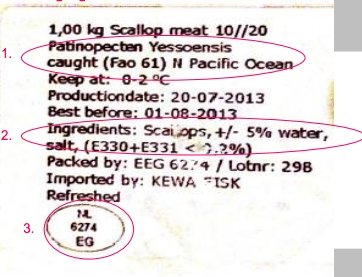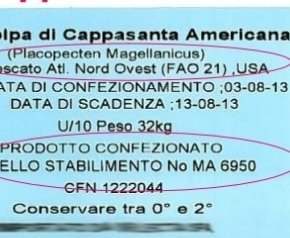Also known in the basin of the Mediterranean sea as Jacob’s comb (from its scientific name, pecten jacobeus), the shell of Saint James is sacred. A symbol for the pilgrims walking to Santiago de Compostela, it was used to drink the water from the rivers on the way to the famous sanctuary on the Iberian peninsula. The Saint Jacques shell needed to be sawn on the cap or on the hat and it was the symbol that would let everyone know that the pilgrim had reached and visited the tomb of Saint James in the distant and green region of Galicia.
Inside the shell of this precious mollusc one can find a sweet yet sapid seafood, highly appreciated in modern cuisine. Scallops belong to the family of Pectinidae, and in some countries they are in fact called “combs” because of the typical shape of their shells. There are many kinds but I would like to focus on the most commonly sold ones.

BAD LABEL. The label of a frozen product: the ingredients include water, absorbed by the scallops so as to raise its weight. From Holland
Let’s start from the
pecten maximus, the giant scallops from Northern Europe. They have a maximum diameter of 15 cm with 15-17 rays on the surface of the shell, and we can tell them because of the large orange ovary. It is also called coral, because of its typical colour, and together with the white part of the abductor muscle, it represents the edible part of this excellent mollusc. We then have the
pecten jacobeus, the smaller scallop, caught in smaller quantities in the Mediterranean Sea, with 14-16 rays on the shell. Then there’s the
Chlamys opercularis, also known as the Queen scallop, which measures 10 cm at most and has 30 rays, and the
Chlamys varia, the Mediterranean species the French call
pètoncle and the Spanish call
zamburina. While in Europe the presence of the ovary is considered as a sign of quality and determines a higher price for this seafood, in the American continent it is discarded. The quality of their scallops is very high and due to their unique sweetness they are highly appreciated all over the world.

GOOD LABEL. The product is 100% natural scallop. From the United States
The fruit of the scallops, that is to say the edible part of this mollusc, has a very low weight when compared to the total weighty, including the shell. Because of this, when it is sold by itself, the retail price can be quite high, from 25 to 60 euros per kilo. This is the reason why this is one of the most imitated products in the food-fraud sector. For instance, I’ve seen small, cylindrical pieces of monkfish cut so as to resemble a scallop, but there’s also the classic scallop
surimi, the pulp of cheap fish tied together artificially to compose the typical circular shape, just like with the more common crab surimi. The latest novelty in the scallop market is the re-composed scallop, made with discarded pieces of scallop tied together with a protein inside a mould that can reproduce scallops of all dimensions.
The worst thing is that one can often find products that are processed and de-frozen without any mention of this step in the label. These products destabilise the market of quality products and, because they are cheaper, they often end up in our dishes without us knowing it. It is important, therefore, to carefully read the label, a trick which allows us at least to understand most of the things that need to be known: fishing area, possible preservatives and whiteners, country in which the product was processed which, if it is different from the one of origin, it is likely to mean that the product was frozen and then de-frozen, processed and then sent according to the market’s demand.